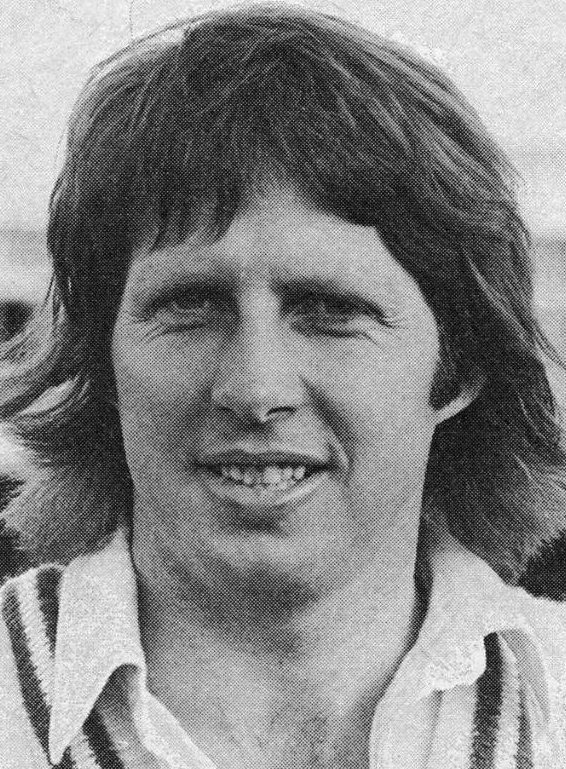Of all 1975 World cup bowlers, the one exciting and most interesting among cricket-watchers is Jeff Thomson, the human hurricane from Australia. Confronted by a bowler so swift, batsmen could think of safer games, such as Russian roulette. As Jeff Thomson walks to his mark to begin hostilities, batsmen see a well-settled man of 6 feet, scarcely looking 14 stone.
A brown mane partly masks his shirt collar. With the balance of a surfboard rider, his approach for most of his 15 running strides is as easy as a medium pacer’s—until the last three soaped-up strides. Near the line, his right boot whips across behind the left for the take-off, slewing his broad shoulders side-on.
From behind his right thigh, a heave of arms propels the ball with a somewhat slinging action. In the explosive force of his high delivery, his athletic body whirls around, pivoting on the ball of his left foot. Effort makes his blue eyes bulge like boiled lollipops. Often, his mouth opens roundly, which is symbolic.
In demeanor, onlookers see no trace of the hot-headed 17-year-old footballer suspended from soccer for having punched a rebuking referee. Though a magazine’s quotes last year set a startling high in callous bloodthirstiness (semi-jocular propaganda taken too literally, he implies), the 1975 Thomson’s main scarcely fits the specifications of savagery.
In fact, he is one of the quietest members of the Australian XI and is not one to stay yarning in the dressing-room until the ice-box runs dry. Jeff doesn’t wear his heart on his rolled sleeve if he has a heart (some batsmen think a cobble-stone has usurped its place).”
Switches from end to end, rejected appeals, batsmen receiving roadside repairs—whatever a day brings, he is unemotional on the field. One eminent writer, Keith Dunstan, looking for signs that he hates batsmen, described his manner as simply indifferent.
Jeffrey Robert Thomson was born in a Sydney suburb, Banks town, on August 16, 1950. At 19, he preferred riding a board on Pacific surf to bowling eight-ball over’s for Banks town. He looked like he was losing to cricket until his friend Len Pascoe persuaded him to resume at 20. Five matches for New South Wales at 22 lifted him into a Melbourne Test against Pakistan.
It was an erratic, wicket-less anticlimax. Among his memories are that in the second inning, his captain gave the ball to medium-fast Max Walker instead.
Jeff Thomson was refused a pain-killing injection for a lump in the ball of his left foot—swelling from a year-old part-mended crack’ in a bone. A doctor advised a winter’s rest. It was 13 months after that Test before NSW chose him again, all steamed up.
His speed and bounce against Queensland drove wicketkeeper Brian Taber yards deeper than he had ever stood for any bowler so far that he did well to hear ‘No-ball!’ called. Queenslanders lost the match but gained a bowler. They persuaded the resettled terror to move to Brisbane, leaving his Sydney job as a concrete-pipe salesman.

In a past-or-present game for an infant’s home, Thomson took five balls to skittle former Test all-rounder Alan Davidson. Cajoled into speaking at a Town Hall reception afterward, Davidson stepped forward, dropping a towel to the floor, and said: ‘I throw in the towel, Jeff— you’re too good for me.’
The frequency of Bob Willis’ and Peter Lever’s bumpers in the first innings of the Test series—especially Lever’s three consecutive balls at the eighth man’s chest—brought a predictable response from Lillee and Thomson, only much faster and steeper. In a couple of overs, Thomson can turn a thigh-pad into a Vienna schnitzel.
His Yorker jolts stumps to rare angles, looking as if paralyzed. Short-of-a-length balls en-dange batsmen’s gloves more than their bails. When he adds more venom to velocity, a full-scale bouncer has wicketkeeper Rod Marsh leaping desperately to save four over-the-top byes. In the Sydney Test, Geoff Arnold greeted Denis Lillee and Jeff Thomson, first ball, with bouncers that caused each to jerk his head back out of harm’s way.
When Geoff Arnold came in a bouncer from Thomson, the first ball, struck his arm. Extending his bowling arm toward Arnold, Jeff Thomson called inquiringly along the pitch: ‘Square?’ For his 33 English wickets in 43 Tests, Australia’s un-trumped ace averaged a victim for every 44 balls (Ray Lindwall and John Snow’s Test striking rate was 60 balls).
When I asked Jeff if had taken more wickets downwind than into the breeze, he murmured: ‘Wouldn’t have a clue.’ His quickest ball looks a fraction swifter than Dennis Lillee, yet judging between them is almost like picking a tiger snake from a copperhead. For generations, an illegal two-up school in Sydney has been known as Thommo’s, so Thomson’s nickname soon became ‘Two-up’.
As his only work during the Test series was on the field, the bachelor boarder lived on his cricket earnings, $1000 in Test allowances, plus a $1000 bonus voted from a lucrative series. Five weeks after he strained the main tendon in his right shoulder at tennis in Adelaide, a medical report considered him fit to bat and bowl in the season’s last match but not to field in a position that could involve violent throwing.
Jeff Thomson scored 61 (his highest) and took nine wickets, making 62 in 12 matches. Victorian captain Ian Redpath confessed: ‘Jeff Thomson had us on the run.’ Above and below the Equator, there is speculation about how many English wickets will allow for the speed and bounce produced in Australia. Besides England’s batsmen, Sussex will be closely interested as Jeff Thomson has expressed a wish to make cricket his living.
